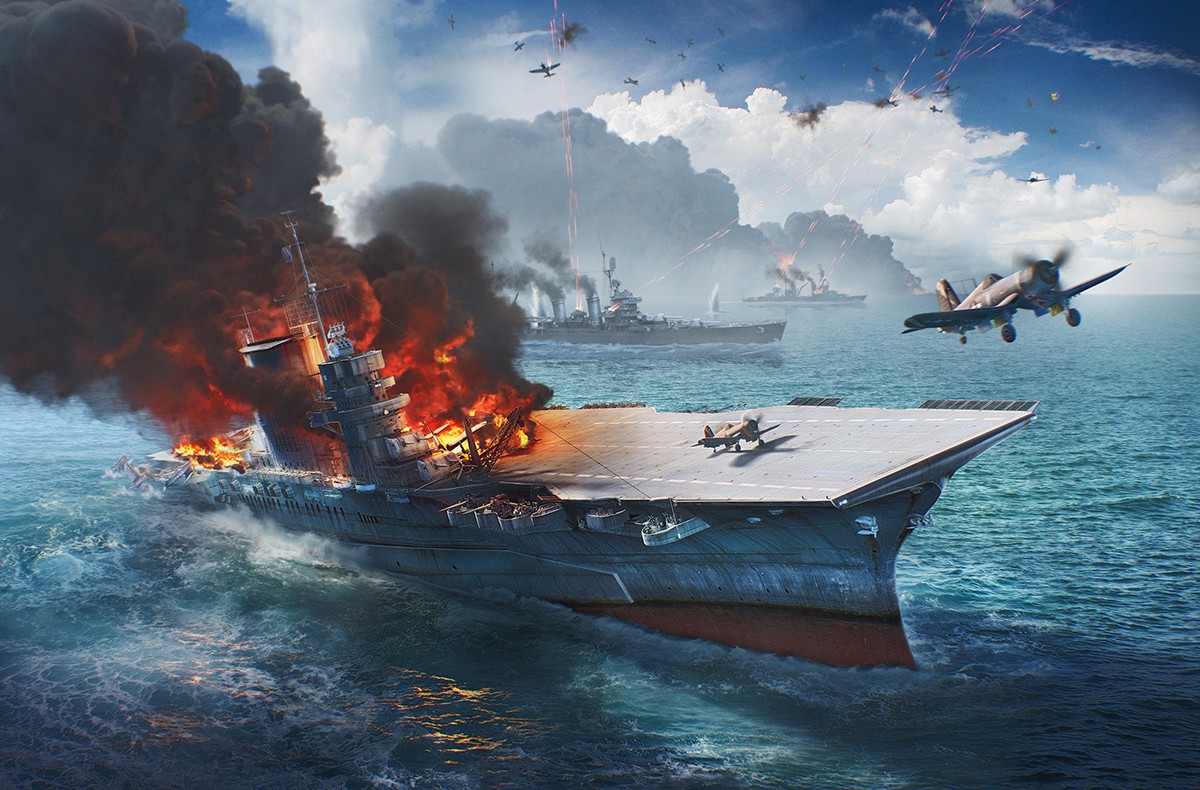Coral Sea Aircraft Carrier - General Features Crew List Commemorative Cruise Book Accidents on Ships USS Coral Sea History of Operations USS Coral Sea Patch Gallery Image Gallery End of Page
USS CORAL SEA is the third MIDWAY-class aircraft carrier and the third Navy ship to commemorate the Battle of Coral Sea in May 1942. The first CORAL SEA was CVE 57 which was renamed ANZIO. Another CORAL SEA sister ship was the CV 43 FRANKLIN D. ROOSEVELT originally named CORAL SEA. The aircraft was named on May 8, 1945.
Coral Sea Aircraft Carrier

Commissioned as CVB 43, CORAL SEA was redesignated attack aircraft CVA 43 on 1 October 1952 and multi-purpose aircraft CV 43 on 30 May 1975. USS CORAL SEA was decommissioned on 30 April 1990. After more than 42 years of service, the largest ship that has ever sunk.
Uss Coral Sea (cv 43) Aircraft Carrier
This section contains the names of crew members who served on the USS Coral. It is not an official list but it contains names of officials who have submitted their information.
The USS Coral ran aground in heavy fog near the mouth of Oakland Estuary. Nine hours later the occupants were freed and admitted to the sewer. It took 10 legs to rescue CORAL SEA which was en route to NAS Alameda's Pier 3 berth after a month of maneuvering when it ran aground. There were no signs of damage and no one was injured.
USS CORAL BEACH and USS IWO JIMA (LPH 2) briefly brushed San Diego, California, causing minor damage.
USS Coral Sea collided with USS Mount Katmai (AE 16) during an ongoing overhaul. Both aircraft were damaged, no one was injured.
Coral Sea: After Action Report
The USS Coral collided with a tug and a cruiser in San Francisco Bay, injuring one barge crew.
USS Coral suffered a fire of unknown origin while in the Puget Sound Naval Shipyard, which damaged medical and dental facilities.
USS Coral suffered a minor engine room fire during repairs at the Norfolk Naval Shipyard. The fire was brought under control within an hour, injuring three crew members and causing $6,000 worth of damage to the aircraft.

USS Coral collided with the Ecuadorian ship NAPO during air operations. There was a 30-foot hole in the bow of the carrier and some radar and communications equipment was damaged. Coral Sea returned to drydock at Norfolk Naval Shipyard, Va.
Uss Coral Sea Hi Res Stock Photography And Images
NAPO was raised above sea level and 7,600 barrels of oil were removed before arriving at Guantanamo for repairs.
An official investigation later blamed the commander-in-chief of Coral Sea for the incident, saying that "he used poor judgment in choosing to remain absent from the bridge throughout the launch and launch ... with Soviet aircraft 1, between 500 yards. and with other vessels well in" the approximate distance of the established captain's limits.
USS CORAL SEA's WestPac Cruise Book from 1981-82 contains an extensive cruise history. Click here to read.
USS CORAL SEA was launched on 2 April 1946 by the Newport News Shipbuilding and Drydock Co., Newport News, VA, sponsored by Mrs. T.C. Kinkaid, commissioned 1 October 1947, with Captain A. P. Storrs, III, in command; And tell the Atlantic Fleet.
File:uss Coral Sea (cv 43) Approaching Pearl Harbor In 1981.jpg
The aircraft began a series of operational milestones when, on 27 April 1948, two P2V-2 Neptunes, piloted by Cmdr. Thomas D. Davis and Lieut. Cmdr John P. Wheatley, was a JATO aircraft as it left Norfolk, Va. This is the first carrier launch of an aircraft of this size and weight. USS Coral departed Norfolk on 7 June 1948 for a voyage to Bahrain and the Caribbean and returned to Norfolk on 11 August.
After a period of repairs, the USS Coral Sea is still operating out of the Virginia Capes. On March 7, 1949, a P2V-3C Neptune, piloted by Capt. The plane flew across the continent, unloaded its cargo on the West Coast, and returned nonstop to land at the Naval Air Station, Patuxent River, MA. After training in the Caribbean, USS Coral Sea departed on her maiden voyage on 3 May 1949. With the 6th Fleet in the Mediterranean, returning 28 September.
On April 21, 1950, the first transport of the AJ-1 Savage Heavy Attack Bomber was carried out from the USS Coral Sea by Capt. Col. USS Coral made this flight on August 31, introducing the long-range bomber to carrier operations. Meanwhile, USS Coral Sea returned to the Mediterranean for duty from 9 September 1950 to 1 February 1951, bringing an impressive force from the 6th Fleet to its important role as a peacekeeper in the Mediterranean.

Repairs and local operations during her return, and training with Air Group 17, prepared her for one more return to the Mediterranean on 20 March 1951. As the flagship of Commander, Carrier Division 6, he participated in the North Atlantic Treaty Organization Exercise Beehive. I. She returned to Norfolk on 6 October for regional and Caribbean operations, followed by the Mediterranean on 19 April 1952. On duty with the 6th Fleet, he visited Yugoslavia, and took Marshal Tito in irons—a day trip to note. Career services. The ship was reclassified CVA-43 on 1 October 1952 while at sea, and returned to Norfolk for overhaul on 12 October.
Uss Coral Sea 8x10 Photo Cva 43 Navy Us Usa Military Aircraft Carrier Ship
USS Coral Sea in Virginia Capes and Mayport, Fla. trained pilots in carrier operations, and in April 1953 departed on a three-day visit to the Judiciary Committee of the House of Representatives. On 26 April, the carrier departed for a tour of duty in the Mediterranean. The fleet was introduced to Spain by a visit, and participated in the NATO Black Wave exercise with Deputy Secretary of Defense R.M. Cues on board as an observer. Returning to Norfolk on 21 October, she conducted tests for the Bureau of Aeronautics and trained members of the Naval Reserve at Mayport, Fla., and Guantanamo Bay.
USS Coral returned to the Mediterranean from 7 July to 20 December 1954, and during this voyage Generalissimo Franco met her as she departed for Valencia, Spain. On her next tour of duty in the Mediterranean from 23 March to 29 September 1955, she called at Istanbul, and participated in NATO exercises.
Norfolk departed Mayport on 23 July 1956 to join Carrier Air Group 10, USS Coral Sea continued on her next voyage to the Mediterranean. It participated in NATO exercises, and received the King and Queen of Greece as guests in October. During the Suez crisis, he withdrew the Americans from the problem area, and remained with Egypt until November.
She returned to Norfolk on 11 February 1957. She left the station on 26 February and visited Santos, Brazil. Valparaiso, Chile; Balboa, CZ, before arriving in Bremerton, Wash., on April 15. USS CORAL SEA was withdrawn for conversion on 24 May 1957, and after completion was refitted on 25 January 1960 to join the fleet. In September 1960, he trained on the West Coast with his new air force, then departed for a tour of duty with the 7th Fleet on the Western Front in September.
Art & Collectibles :: Uss Coral Sea Cva 43, Custom Personalized Photo, Us Navy Vets. Aircraft Carrier
Installation of the Pilot Landing Aid Television (PLAT) system on the USS Coral Sea was completed on 14 December 1961. It was the first vendor to install this system for operational use. Designed to provide videotape of every landing, the system proved useful for training purposes and in analyzing landing accidents, thus making it an invaluable tool in promoting safety. By 1963, all attack aircraft were equipped with PLAT and plans were underway for installation at CVS and shore stations.
After the Gulf of Tonkin incident in August, USS Coral Sea departed for duty with the United States Seventh Fleet on 7 December 1964. On February 7, 1965, USS Coral Sea with the carriers USS Ranger (CVA 61) and USS Hankook (CVA 19) attack military facilities and installations near Dong Hoi, southern North Vietnam. attacked the war areas. The attacks were in retaliation for a devastating Viet Cong attack on installations near Pelicu in South Vietnam. On 26 March, the 7th Fleet Group began participating in Operation Rolling Thunder, a systematic bombing campaign against military targets throughout North Vietnam. USS Coral Sea pilots attack coastal radar stations in the Van Son Islands and area. USS Coral remained on deployment until returning home on 1 November 1965.
USS Coral continued to deploy to the West Pac/Vietnam until 1975. 26 July 1967 to 6 April 1968; From 7 September 1968 to 15 April 1969; From 23 September 1969 to 1 July 1970; 12 November 1971 to 17 July 1972; 9 March 1973 to 8 November; and from

Aircraft carrier san diego, aircraft carrier at sea, aircraft carrier, aircraft carrier sea trials, aircraft carrier museum ships, aircraft carrier lego set, lexington aircraft carrier, coral sea carrier, midway aircraft carrier, philippine sea aircraft carrier, uss coral sea aircraft carrier, army aircraft carrier

0 Comments